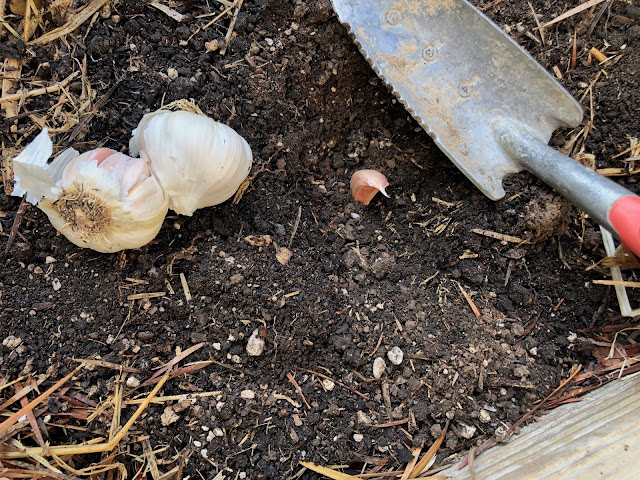
|
|
Plant garlic now and you'll have plenty to go with those summer tomatoes.
(Photo: Kathy Morrison)
|
Is there room for garlic in your garden? If not, there should be!
This easy-to-grow and flavorful crop does more than season food. It also helps protect your garden from several pesky pests. But be careful where you plant it; not all vegetables like garlic as a neighbor.
This week is traditional planting time for garlic in Northern California. Plant on the shortest day (or close to it), then harvest on the longest day (which will be June 20). That planting/harvest schedule gives garlic bulbs six months to mature (which is about just right).
Why grow your own garlic? For starters, we eat a lot of it, averaging 2.5 pounds per person each year.
California is the Garlic State, producing most of the nation’s supply. Why? It grows great in our mild climate.
The best garlic to grow in Sacramento? According to UC Davis, go for “softneck” or silver skin varieties. These varieties put their energy into making plump bulbs and rarely bolt. California Early and California Late are among the most popular softneck garlic varieties to grow here.
“Hardneck” varieties, also called “top-setting garlic,” produce a strong stem or “scape,” which is its own culinary delight. Top-setters also yield dozens of little bulbils – which look like little mini cloves – at the top of that scape. Also like cloves, those bulbils can be planted to produce new garlic plants. The most common hardneck variety grown in California is Creole, a popular purple-skinned garlic that’s a favorite in Mexico.
Garlic plants do double duty as a natural pest deterrent. Among the pests that stay away from garlic are codling moths, spider mites, aphids, ants and snails, plus several species of flies and gnats.
Deer and rabbits don’t like garlic either. Strategically planted at the perimeters of the garden, garlic can form a scent barrier to these hungry critters.
Garlic naturally builds sulfur content in soil, acting as a natural fungicide. But not all vegetables appreciate this extra sulfur. Avoid planting garlic near asparagus, beans, peas, parsley or sage; it will actually stunt their growth.
For its own health, garlic can be finicky about its planting place, too. Avoid planting garlic in the same spot where onions, garlic or other alliums have grown in the past two or three years; that cuts down on potential pest problems and other issues.
Here are more tips for garlic-growing success:
* Garlic needs sun for success; choose a spot with full sun. But they don’t need much space; allow 3 to 4 inches of room between plants.
* Garlic needs good drainage. Plant in raised beds or containers for best results. Add a few scoops of well-aged compost before planting.
* Plant the individual cloves, not a whole bulb. Break apart a bulb within 24 hours of planting; that preserves the piece of “foot” at the base of the clove that will form new roots.
* Plant the cloves 2 inches deep with the pointy end up, spaced 6 to 8 inches apart. Water once, then let rest. They’ll need water once a week through January and early February; usually rain will take care of that irrigation.
* After the cloves sprout, water once or twice a week. Avoid soggy soil (that prompts rot), but keep soil from completely drying out.
* Garlic doesn’t like competition; remove any weeds around the young plants.
For lots more on growing great garlic (and onions, too), visit the Vegetable Research and Information Center resource page from the UC Cooperative Extension:
https://vric.ucdavis.edu/veg_info_crop/garlic.htm

